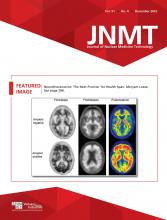Abstract
Due to high iodine loading from iodinated contrast media, the thyroid uptake of common radiopharmaceuticals ([99mTc]NaTcO4 and [123I]NaI) can be influenced up to 2 mo after administration. In such cases, and generally when differential diagnosis between productive and destructive thyrotoxicosis is necessary, [99mTc]Tc-sestamibi scintigraphy could be an option. This case highlights the role of [99mTc]Tc-sestamibi in the evaluation of thyrotoxicosis in a patient with a blocked thyroid gland as a result of stable iodine saturation.
Iodinated contrast media are widely used for radiographic studies today. Since iodine takes part in thyroid hormone synthesis by the thyroid gland, the use of iodinated contrast media blocks the thyroid gland because of iodine saturation. The [99mTc]Tc-sestamibi uptake mechanism does not follow the metabolic path of iodine (1). Furthermore, its use is suggested for characterization of amiodarone-induced thyrotoxicosis (2,3).
CASE REPORT
A 56-y-old man with locally advanced prostate cancer being treated under a clinical trial with pembrolizumab and lenvatinib was referred to our hospital for acute medical care because of an impaired general condition, confusion, sweating, and weakness in the left arm. CT of the brain, neck, thorax, and abdomen was performed with intravenous administration of an iodinated contrast agent (360 mg of iodine/kg of body weight) (Fig. 1). The patient’s thyroid hormone status was subsequently assessed and revealed thyrotoxicosis (thyroid-stimulating hormone, <0.01 mIU/L [0.27–4.2 mIU/L]; free thyroxine, >100 pmol/L [12.0–22.0 pmol/L]; free triiodothyronine, 43.7 pmol/L [3.1–6.8 pmol/L]; thyrotropin receptor antibody, 2.0 IU/L [0–1.8 IU/L]). Even though destructive thyrotoxicosis is a common side effect of immunotherapy, the patient’s preliminary clinical and biochemical status was considered to be related to an upcoming thyrotoxic crisis; this could have led the patient to the intensive care unit for active observation and treatment with high doses of β-blockers, thionamides, iodine, and hydrocortisone.
(A) Contrast-enhanced coronal CT image of neck region at level of thyroid gland. (B) Static anterior images acquired at 10 min (left) and 60 min (right) after [99mTc]Tc-sestamibi injection. Red = thyroid region of interest; blue = background region of interest.
The patient was referred subsequently to our department for assistance with differentiating between a diagnosis of productive thyrotoxicosis and a diagnosis of destructive thyrotoxicosis. After intravenous administration of 200 MBq (5.4 mCi) of [99mTc]Tc-sestamibi, anterior static images of the neck region were acquired at 10 and 60 min according to our local protocol for thyroid scintigraphy with [99mTc]Tc-sestamibi. The earlier image showed a hint of visible thyroid uptake, whereas no thyroid uptake was detected in the later image. The thyroid-to-background ratio was low, at 1.24 and 1.22 for the earlier and later images, respectively. Thyroid uptake was similarly low, at 0.068% and 0.048%, respectively. Quantification was performed according to previous studies to assist the simple qualitative assessment (4,5). Due to low thyroid uptake and uniformly fast washout of [99mTc]Tc-sestamibi, the patient was diagnosed with destructive thyrotoxicosis and treated effectively with high-dose prednisolone.
DISCUSSION
Iodine overload due to iodinated contrast media reduces iodine metabolism (trapping and organification) within the thyroid gland. The use of conventional radiopharmaceuticals such as [99mTc]NaTcO4 and [123I]NaI cannot provide any useful information about the thyrotoxicosis manifestation. [99mTc]Tc-sestamibi is a lipophilic cation belonging to the isonitrile group. Its distribution is affected mainly by the mitochondrial density and the negative plasma membrane potentials (3).
In our case, in which our patient’s thyroid gland was saturated by intravenous administration of 36 g of iodine a couple of days beforehand, the [99mTc]Tc-sestamibi succeeded in differentiating between productive and destructive thyrotoxicosis, allowing appropriate, cost-effective, and successful treatment.
CONCLUSION
[99mTc]Tc-sestamibi thyroid scintigraphy is a promising study when differential diagnosis between productive and destructive thyrotoxicosis is needed in patients with iodine loading due to radiographic contrast agents.
DISCLOSURE
No potential conflict of interest relevant to this article was reported.
Footnotes
Published online Jul. 11, 2023.
REFERENCES
- Received for publication March 3, 2023.
- Revision received May 10, 2023.








